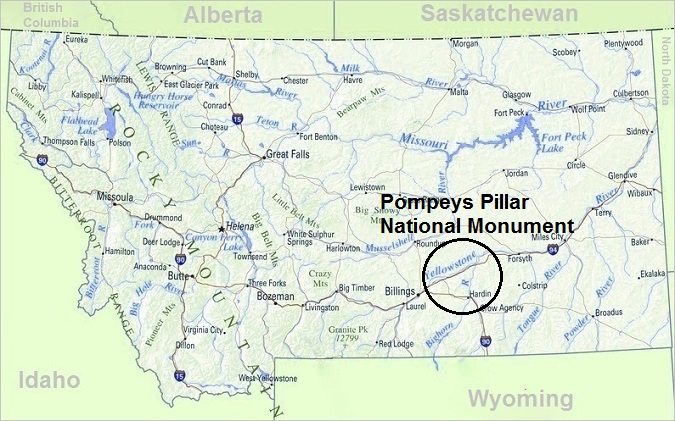Pompeys Pillar National Monument
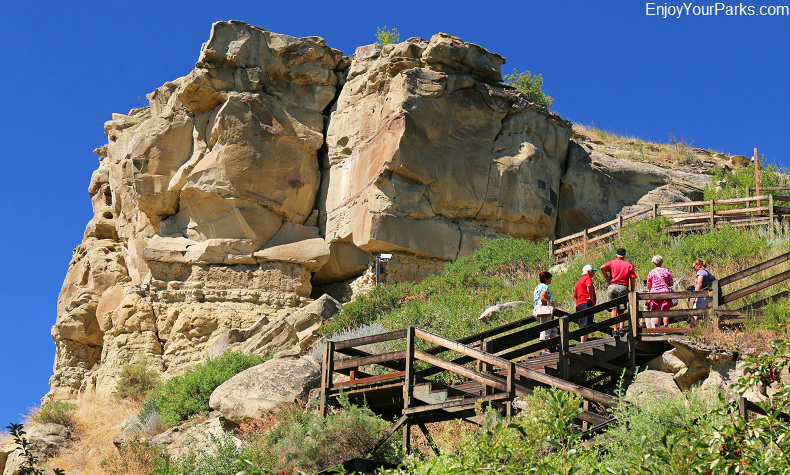
Pompeys Pillar National Monument, Montana
Pompeys Pillar National Monument
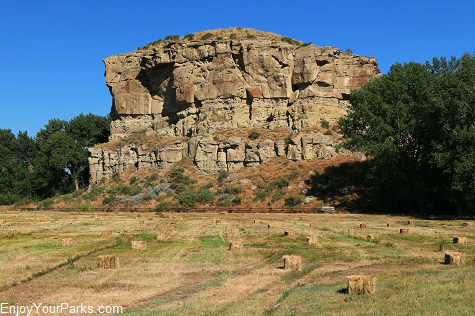 Pompeys Pillar National Monument is home to the only remaining physical evidence found along the actual route followed by the Lewis and Clark Expedition of 1804-1806. This physical evidence is Captain William Clark's signature and date carved into the rock of this fascinating sandstone formation found near the banks of the Yellowstone River. Managed by the U.S. Bureau of Land Management (BLM), Pompeys Pillar is located along Interstate 94 just 25 miles northeast of Billings, and is definitely among the top tourist destinations in Montana.
Pompeys Pillar National Monument is home to the only remaining physical evidence found along the actual route followed by the Lewis and Clark Expedition of 1804-1806. This physical evidence is Captain William Clark's signature and date carved into the rock of this fascinating sandstone formation found near the banks of the Yellowstone River. Managed by the U.S. Bureau of Land Management (BLM), Pompeys Pillar is located along Interstate 94 just 25 miles northeast of Billings, and is definitely among the top tourist destinations in Montana.
Captain William Clark and his men were on their return trip to St. Louis after a harrowing adventure through Montana the year before trying to find a water passage to the Pacific Ocean, when they stopped at this interesting sandstone pillar along the banks of the Yellowstone River on July 25, 1806. Clark was fascinated with the rock structure and proceeded to explore and climb it. When he reached the top of the 150 foot high pillar, he wrote, "had a most extensive view in every direction...."
About The Name "Pompey"
 Captain William Clark named the 150 foot tall sandstone pillar after Sacagawea's son, Jean Baptiste Charbonneau. As you may recall, Sacagawea was Lewis and Clark's guide through the entire expedition, and proved to be a tremendous asset and a major contributor to the expedition's success.
Captain William Clark named the 150 foot tall sandstone pillar after Sacagawea's son, Jean Baptiste Charbonneau. As you may recall, Sacagawea was Lewis and Clark's guide through the entire expedition, and proved to be a tremendous asset and a major contributor to the expedition's success.
Captain Clark had nicknamed her young son "Pomp" during the expedition, and on that day in 1806 he decided to name the outcropping "Pomps Tower".
Later in 1814, the named was changed to the current title of "Pompeys Pillar". Pompy means "Little Chief" in Shoshone.
11,000 Years Of Human Involvement
Because of the way Pompeys Pillar stands out for many miles in all directions, archeological evidence tells us that this unusual geologic formation attracted humans dating back to at least 11,000 years ago. There are many Native American petroglyphs and pictographs found on the this historic pillar, as well as signatures of early pioneers who ventured into this wild, untamed land.
Geology
Pompeys Pillar is 150 feet tall and is make of sandstone from what is known by geologists as the Cretaceous Hell Creek Formation. This sandstone was initially deposited on the beach of an ancient sea approximately 70 million years ago, and eventually hardened into the sandstone you see today. The base of Pompeys Pillar is about 1 acre in size.
Pompeys Pillar Interpretive Center
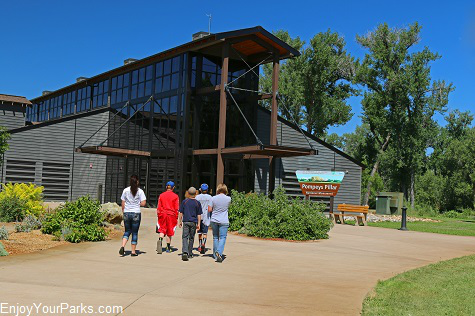 The new Pompeys Pillar Interpretive Center was opened in 2006, and is very well done.
The new Pompeys Pillar Interpretive Center was opened in 2006, and is very well done.
Not only is it a gorgeous 5,700 square foot structure, but the exhibits are very interesting and informative.
These displays focus on Captain Clark's (and Sacagawea's) journey down the Yellowstone River Valley in 1806 as he and his team were returning from their historic expedition.
We recommend that you visit the visitor center first before climbing the stairs up the side of Pompeys Pillar. You will have a much better understanding and appreciation of what occurred at this historic place.
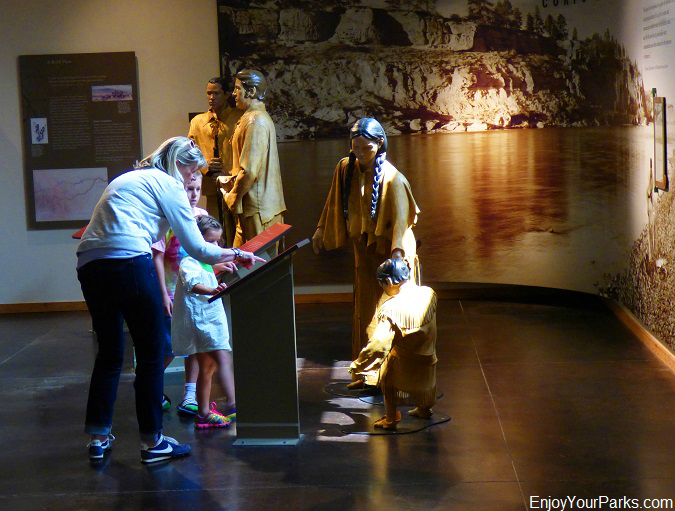
Visitors enjoying an exhibit at the Pompeys Pillar National Monument Visitor Center.
Pompeys Pillar Boardwalk
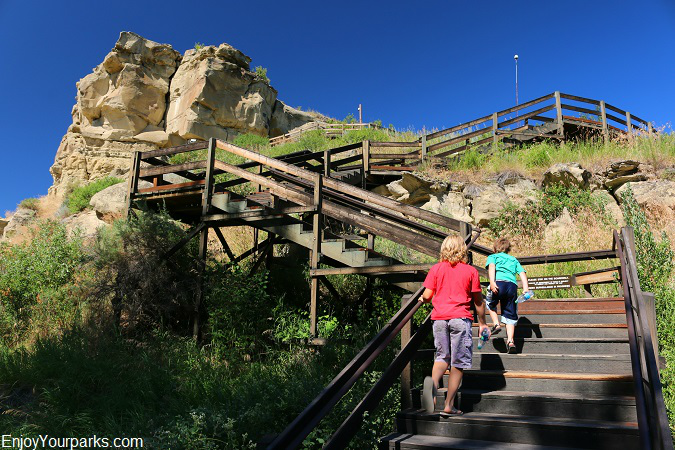
The boardwalk at Pompeys Pillar takes visitors up to Clark's signature as well as to the top of the pillar.
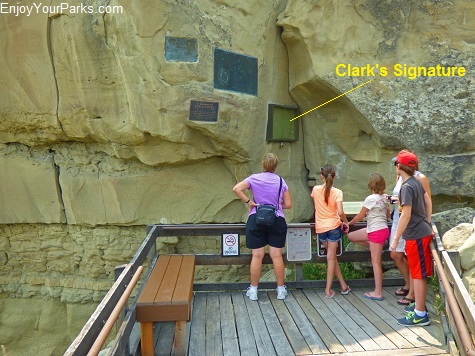 There is a wonderful boardwalk that takes you up the side of Pompeys Pillar to Clark's signature and date that is carved in the side of Pompeys Pillar.
There is a wonderful boardwalk that takes you up the side of Pompeys Pillar to Clark's signature and date that is carved in the side of Pompeys Pillar.
Once you've taken in this incredible National Treasure, the boardwalk then continues up to the very top of Pompeys Pillar, where you can enjoy the same view that Clark saw those many, many years ago.
Clark remarks in his journal when he reached the top of the 150 foot high pillar, "Had a most extensive view in every direction...."
As you stand where Captain William Clark stood, and as you look at his signature carved into the rock, it will really hit home the significance of this pillar, and the significance of what Lewis and Clark accomplished over 200 years ago... and here you are, just as Captain Clark was so many years ago.
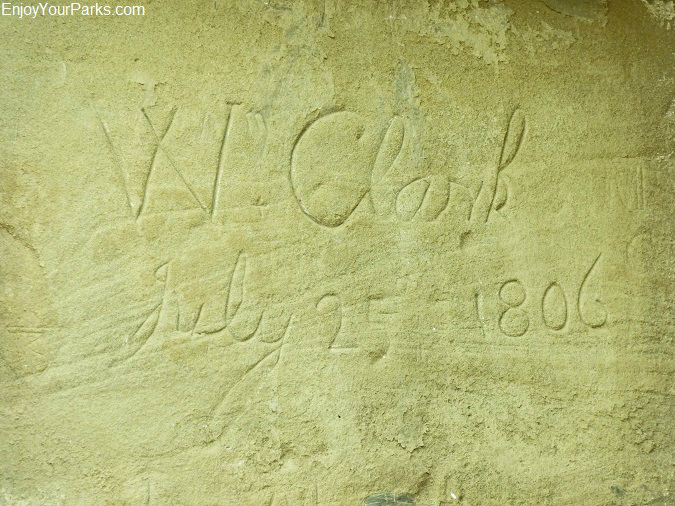
Captain William Clark's signature carved into the rock at Pompeys Pillar National Monument in Montana.
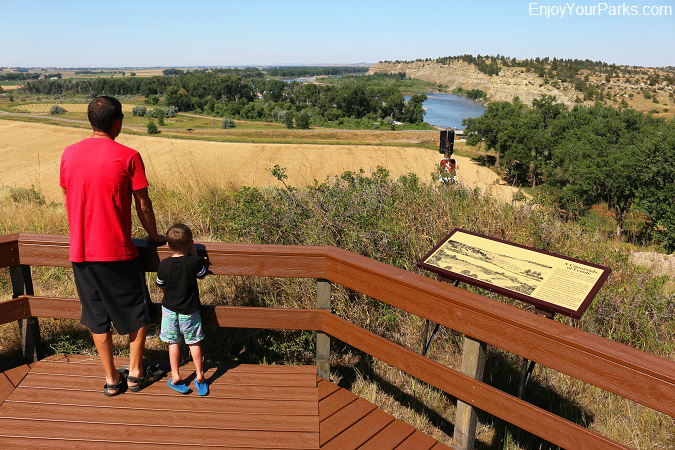
Visitors standing on the top of Pompeys Pillar, enjoying the view to the west, which includes the Yellowstone River.

The Yellowstone River runs directly by Pompeys Pillar. There are some very nice maintained trails near the pillar that take you to the shore of the Yellowstone River, which is where we took this photo from.
Pompeys Pillar National Monument is a very special place. The history here is hard to wrap your head around, and it really comes to life as you further explore and discover Pompeys Pillar National Monument. Knowing that one of America's bravest men, on one of the most important expeditions in American history, was standing exactly where you are standing, and carved his name in this spot over 200 years ago....the feeling is impossible to explain. All we can say is that we highly recommend that you spend time at Pompeys Pillar National Monument. You will be very glad you did.

Pompeys Pillar National Monument in Montana.



